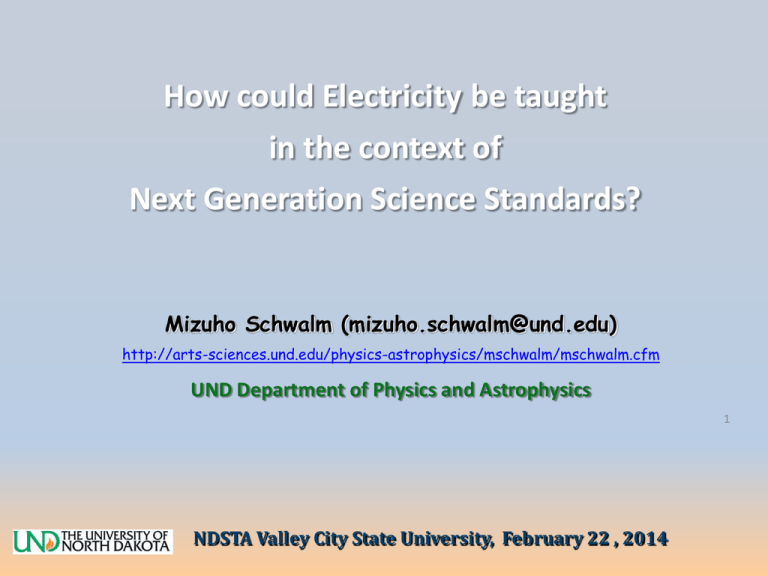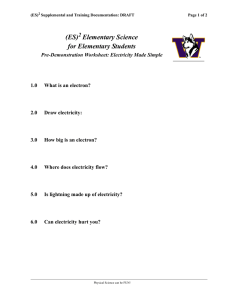How could Electricity be taught in the context of
advertisement

How could Electricity be taught in the context of Next Generation Science Standards? Mizuho Schwalm (mizuho.schwalm@und.edu) http://arts-sciences.und.edu/physics-astrophysics/mschwalm/mschwalm.cfm UND Department of Physics and Astrophysics 1 NDSTA Valley City State University, February 22 , 2014 Organization of Talk I. About NGSS Physics content Responses expressed by AAPT Feb 2013 and July 2013 II. Active Physics lead by Arthur Bisenkraft Example: Electric circuits (Section 1& 2) III. Discussions (electric circuits) As you are aware, this February, the State of North Dakota will adopt NGSS. So far, ten states have adopted it, including ND. AAPT (American Association of Physics Teachers) and APS (American Physical Society) have supported NGSS. Are we ready? How to implement it? I. About NGSS Physical Sciences Evolved from a Framework for K-12 Science Education: Practice, Crosscutting Concepts, and Core Ideas. Final version April 2013 AAPT is one of organizations, that carefully read the content and contributed extensive inputs. Physical Sciences core ideas: basically from kindergarten to grade 12 there is a gradual build up of performance expectations in four areas. I. Matter and interaction II. Motion and stability III. Energy IV Waves and their applications in technologies for information transfer At first glance you will notice that the several critical things are missing from the standard introductory physics. How about electric circuits? Geometrical optics? AAPT’s responses to NGSS Shortly after the second draft of NGSS became available, AAPT issued the seven page-long letter of response. Basically AAPT was disappointed with the draft. The executive summary is posted at http://www.aapt.org/Resources/policy/upload/AAPT_Summary_of _NGSS_Response_1_February_2013.pdf Words I can find in that response is “unclear”, “scientifically in accurate”, .. And so on so on. Please read it if you are interested. One of the comment in that letter was: “We are concerned that there seem to be almost no standards relating to electric circuits.” In July 2013 after the final draft became available AAPT issued a letter of support for adopting NGSS. The AAPT July letter of support can be found http://www.aapt.org/Resources/policy/upload/NGSS-AAPTLetterhead-Response-130729.pdf First paragraph of the letter “The American Association of Physics Teachers (AAPT) supports the adoption and implementation of common, nationwide science education standards to provide a coherent science and engineering education program for all K-12 students, not just those aiming for science, technology, engineering and mathematics (STEM) careers. The Associations supports the NGSS as a guide for the development of assessments for.. student performance in ..” In its second paragraph AAPT says “We emphasize, however, that the Science Standards are not meant to be a guide for curriculum development. Further work will be required to develop curricula to support students as they prepare for the assessments built on the Science Standards …” Important point of the AAPT letter is that NGSS is not yet a guide for the curriculum development. In other words, we need to work further. Is there any work already done so that teachers can use it? II. Active Physics: Physics for All Active Physics: Physics for All (Time to change.com) A project based inquiry Approach Arthur Eisenkraft Textbook organization There are 9 chapters Each Chapter consists of 6-10 sections Active Physics Chapter Organization CH 1 Driving the Roads (Measurement, Motion in 1D, Circular Motion) CH 2 Physics in Action (Newton’s Laws of Motion, Projectile Motion, Friction, Energy) CH 3 Safety (Inertia, Newton’s Second Law, Momentum and Impulse) CH 4 Thrills and Chills (Potential energies, Newton’s Law of Universal Gravitation, Hook’s law, Apparent Weight, Circular Motion, Work and Power, Force and Energy) CH 5 Let Us Entertain You (Waves & Sound, Geometrical Optics) CH 6 Electricity for Everyone (DC electricity and Thermal Physics) CH 7 Toys for Understanding (Electricity and Magnetism, Motors, AC Circuits, Electromagnetic Waves, Spectrum) CH 8 Atoms on Display (Electrostatics, Nucleus, Hydrogen Atom, Waveparticle Model, Nuclear Force, Radioactive Decay, Nuclear Fission and Fusion) CH 9 Sports on the Moon Physics in Electricity for Everyone (Chapter 6 Active Physics) Electricity Conservation of Energy Electrical Efficiency Energy (E = Pt) Power P = VI Fuses Generators Load Limits Ohm’s Law Series Circuits Parallel Circuits Resistance, Voltage, Current Switches Heat Heat Energy Heat Energy and Specific Heat Heat Transfer Entropy Thermodynamics Utility bills Chapter Organization (Active Physics Chapter6) Each chapter begins with a description of a scenario and a project. 1. 2. 3. 4. 5. Scenario Your Challenge Criteria for Success Engineering Design Cycle Physics Corner (terms) Chapter Organization (Active Physics Chapter6) Section format 1. What Do You See? 2. What Do you Think? 3. 4. 5. 6. Investigate Physics Talk Active Physics Plus* What Do You Think Now? 7. Physics Essential Questions What does it mean? (articulating physics concepts) How do you know? (experimental evidence) Why do you believe? (it connects with other physics concepts, understanding physics world) 8. Physics to Go (Homework) Chapter Organization (Active Physics Chapter6) Review plus at the end of chapter 1. 2. 3. 4. 5. Physics You Learned (Chapter summary) Physics Chapter Challenge on projects Physics Connections to Other Sciences Physics at Work Physics Practice Test Active Physics Chapter 6 Electricity for Everyone Scenario Imagine you and your team members are part of international group called Homes for Everyone (HFE). The source of electricity chosen for the project is a 2.4 kW wind generator. Average monthly energy output is 90KWh (3KWh/day) DC-AC converter needed. Your Challenge Decide which electrical appliances can/should be included to meet the basic needs. Making educational instruction how to stay within the power and energy limits. Make a wiring diagram. Standard for Excellence Engineering Design Cycle Section 1 Generating Electricity What Do You Think? – How is the electricity that you use generated? – Oil can be used as a source of energy to generate electricity. What other sources of energy can you identify? Investigate – Part A: What Electrical Appliances Do you Really Need? – Part B: Investigating a Closed Circuit Physics Talk Generating Electricity Electrical Circuit Energy Transformation Essential Questions, Reflecting on the Section and the Challenge Physics To GO Section II Electron Shuffle I © Its About Time, Herff Jones Education Division Electron Shuffle (Round 2) © Its About Time, Herff Jones Education Division Voltage (volts) Joule of energy /Coulomb Current (ampere) Round 3 : (vary voltage, current = 1A) Round 4: (voltage =1V, vary current) Electron Shuffle bag of pretzels students delivering pretzels students receiving pretzels number of pretzels number of students passing a point every second number of pretzels per second received by the student(s) Electrical Circuit battery charges light bulb voltage (1 V = 1J /C) current (1A = 1C/s) Power-brightness of bulb (1W = 1 J/s) What Do you Think Now? What is electricity and how does it move through a circuit? Reflecting on the section and the Challenge Physics to GO Section 3 Series and parallel Circuits Section 4 Ohm’s law: Putting up a Resistance Section 5 Electric Power: Load Limit Section 6 Current, Voltage, and Resistance in Parallel and Series Circuits: Who is in Control? Section 7 Laws of Thermodynamics: Too Hot, Too Cold, Just Right Section 8 Energy Consumption: Cold Shower Section 9 Comparing Energy Consumption: More for Your Money III. Discussions Quick Review on CASTLE (Capacitor Aided System for Teaching & Learning Electricity) Basics Section 1 through 4 (Series circuit) CASTLE vs. the approach by Active Physics Chapter 6 ---Advantages and disadvantages of the two models III. Discussions Quick Review on CASTLE (Capacitor Aided System for Teaching & Learning Electricity) 1. What is moving in the wire? A series circuit What is moving? Which direction is it moving? Circuit (unbroken loop of electrical components) Quick Review: CASTLE 2. What do the bulbs do to moving charge? (series circuit) Flow rate (electric current) and number of bulbs (resistors) Quick Review: CASTLE 3. Where does the moving charge originate? Quick Review: CASTLE How is charge different from energy ? Quick Review: CASTLE 4. What makes charge moving in a circuit? Potential Difference Across a capacitor Quick Review: CASTLE 4. What makes charge moving in a circuit? How can we visualize potentials (pressure level) in a circuit? Color coding for electric potential in a circuit Red Highest, Battery (+) Orange High Yellow Normal (not zero) pressure Green Blue Low Lowest, Battery (─) Normal Normal Quick Review: CASTLE 4. What makes charge move in a circuit? How can we visualize potentials (pressure level) in a circuit? Color coding for electric potential in a circuit CASTLE vs. approach by Active Physics Electron Shuffle How are they different in terms of approaches? CASTLE: Systematic. In-line to traditional physics 1. What is moving in the wire? (charge is moving in the wire) 2. What do the bulbs do to the moving charge? (flow rate and number of light bulbs) 3. Where does the moving charge originate? (capacitor, genecon, energy transfer) 4. What makes charge move in a circuit? (pressure difference pushes charges to move) Electron Shuffle (Round 2) “Battery voltage is one volt which equals one joule of energy for each coulomb of charge” “Please move along, one coulomb per second is one ampere of current” Terms and concepts are given as needed. Meaning is developed later and redefined. Energy and energy transfer first. CASTLE vs. approach by Active Physics Electron Shuffle How are they different in terms of approaches? The brightness of light bulbs is closely related to the power dissipated Energy transferred/time. This is clear in the electron shuffle model Electron Shuffle (Round 2) . In CASTLE the brightness of the bulb is related to flow rate (current) and pressure difference separately. This may give students the impression the brightness is related to the pressure difference or flow rate. Electron shuffle model may be difficult for students to act out in the model when current is introduced. Also the model may introduce confusions. Who gets tired? Charges, light bulbs or battery? Other thoughts? Conclusions How can we implement CASTLE under NGSS? Active Physics is exciting but drastically different from traditional mode of teaching physics. Under the constraints, is it worth implementing it? There are lots of unknowns. Will the project-type approach work for average classes? We need some sort of pilot study. Is anyone interested? If so, I would love to cooperate. If North Dakota adopte NGSS, we have to work a lot, and cooperation and communication among physics teachers and AAPT is essential. Thank you!





